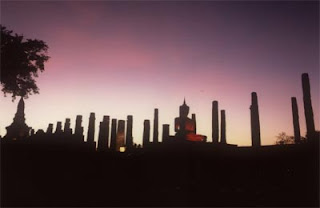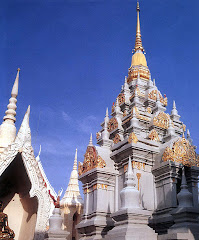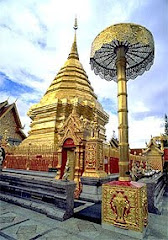

 Situated in the heart of the town,Wat Mahathat was built in accordance with Indian ancient concept of Mandala. This significant temple comprises the main chedi (stupa), a vihara (assembly hall of worship) and mandapas (a square form building with a palatial spired roof for housing an Image of Buddha), an uposatha (the ordination hall) and 200 subordinate chedis.
Situated in the heart of the town,Wat Mahathat was built in accordance with Indian ancient concept of Mandala. This significant temple comprises the main chedi (stupa), a vihara (assembly hall of worship) and mandapas (a square form building with a palatial spired roof for housing an Image of Buddha), an uposatha (the ordination hall) and 200 subordinate chedis.
Surrounded by 8 chedis, the main one in the centre has a graceful shape of lotus bud characterizing the art of Sukhothai. Among the 8 chedis forming 4 sides of the main stupa, the four ones at the corners belong to the Hariphunchai - Lanna art style while the other four lying in between each have a prasada - shaped body topped with a spire in Sukhothai style and decorated with stuccoed reliefs under the influence of Sri Lankan art. Presumably, the main chedi had originally been constructed in the latter style before it was rebuilt in the lotus bud shape.
The base of the main chedi is decorated with stucco relief of Buddhist disciples walking with their hands clapped together in salutation.
Stone Inscription No. 1 says ".... At the centre of Sukhothai there are a vihara, a golden Buddha Image, Phra Attharot Buddha Images, large Buddha Images, medium Buddha Images "

The golden Buddha image referred in the inscription is understood to be a bronze Buddha Image in the posture of subduing Mara (the Evil One) to be enshrined in the royal vihara of Wat Mahathat. In the reign of King Rama I (the late 18th c. AD) of the Rattanakosin Period, this Buddha image was removed by raft to be installed at Wat Suthat Thepwararam in Bangkok. The singificant Buddha image was later named Phra Si Sakkayamuni by King Rama II. At present, the large pedestal of this Buddha Image still remains to be seen at the royal vihara of Wat Mahathat.
The Buddha images mentioned as Phra Attharot refer to standing Buddha Images of 12 metres in height enshrined in the mandapas situated on both sides of the principle chedi.
Next to the royal vihara towards the east stands a tall vihara of 1.5 metres in height. Its base decorated with stucco relief of lotus-petals.This vihara was built later in Ayutthaya style, and the little space between to front of the vihara and a wall enclosing it was out of proportion of the height of the building. This is a reason why it was called the tall vihara.
Within the compound of Wat Mahathat there is a group of stupas situated to the south of the main chedi. At its centre stands the one with five spires, second to the main chedi in size.
source: www.su.ac.th
Technorati tags : Sukhothai /Wat Mahathat /Wat /Thailand Temple /thai temple
Saturday, April 14, 2007
Wat Mahathat :Sukhothai
Posted by
myplot'blog
at
1:37 AM
![]()
Labels: Sukhothai, thai temple, thailand temple, wat, Wat Mahathat
Subscribe to:
Post Comments (Atom)









No comments:
Post a Comment